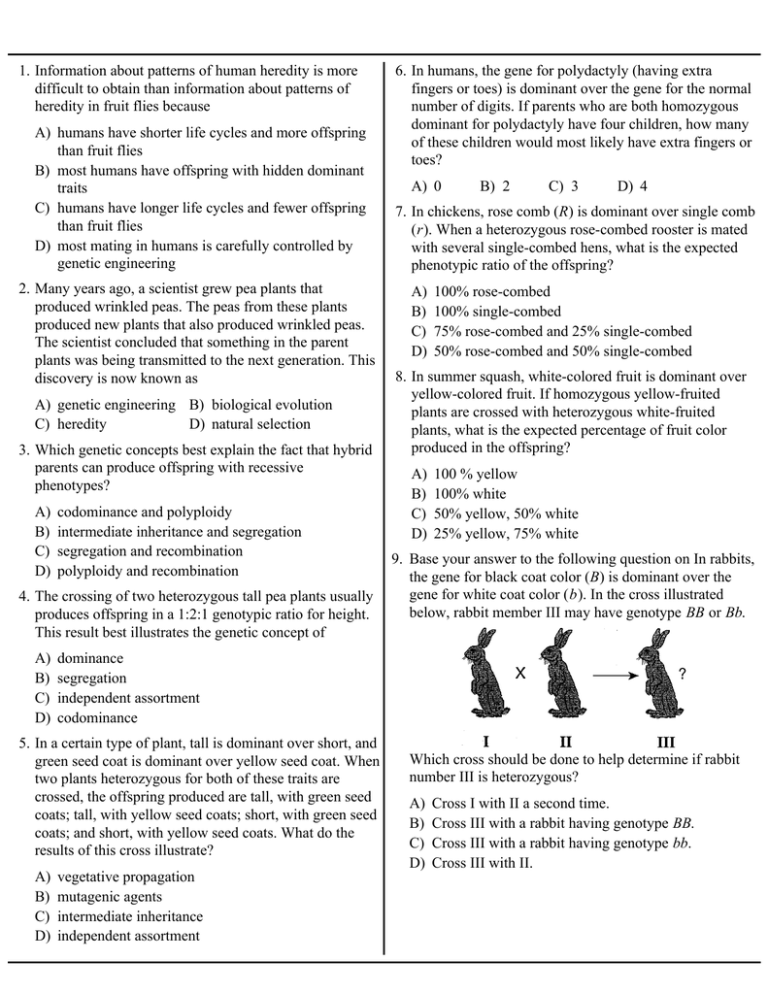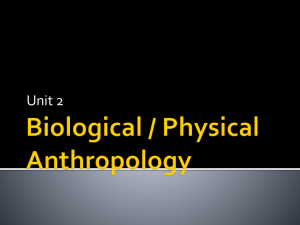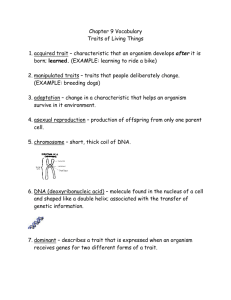1. Information about patterns of human heredity is more 6. In humans, the gene for polydactyly (having extra
advertisement

1. Information about patterns of human heredity is more difficult to obtain than information about patterns of heredity in fruit flies because A) humans have shorter life cycles and more offspring than fruit flies B) most humans have offspring with hidden dominant traits C) humans have longer life cycles and fewer offspring than fruit flies D) most mating in humans is carefully controlled by genetic engineering 2. Many years ago, a scientist grew pea plants that produced wrinkled peas. The peas from these plants produced new plants that also produced wrinkled peas. The scientist concluded that something in the parent plants was being transmitted to the next generation. This discovery is now known as A) genetic engineering B) biological evolution C) heredity D) natural selection 3. Which genetic concepts best explain the fact that hybrid parents can produce offspring with recessive phenotypes? A) B) C) D) codominance and polyploidy intermediate inheritance and segregation segregation and recombination polyploidy and recombination 4. The crossing of two heterozygous tall pea plants usually produces offspring in a 1:2:1 genotypic ratio for height. This result best illustrates the genetic concept of A) B) C) D) A) 0 B) 2 C) 3 D) 4 7. In chickens, rose comb (R) is dominant over single comb (r). When a heterozygous rose-combed rooster is mated with several single-combed hens, what is the expected phenotypic ratio of the offspring? A) B) C) D) 100% rose-combed 100% single-combed 75% rose-combed and 25% single-combed 50% rose-combed and 50% single-combed 8. In summer squash, white-colored fruit is dominant over yellow-colored fruit. If homozygous yellow-fruited plants are crossed with heterozygous white-fruited plants, what is the expected percentage of fruit color produced in the offspring? A) B) C) D) 100 % yellow 100% white 50% yellow, 50% white 25% yellow, 75% white 9. Base your answer to the following question on In rabbits, the gene for black coat color (B) is dominant over the gene for white coat color (b). In the cross illustrated below, rabbit member III may have genotype BB or Bb. dominance segregation independent assortment codominance 5. In a certain type of plant, tall is dominant over short, and green seed coat is dominant over yellow seed coat. When two plants heterozygous for both of these traits are crossed, the offspring produced are tall, with green seed coats; tall, with yellow seed coats; short, with green seed coats; and short, with yellow seed coats. What do the results of this cross illustrate? A) B) C) D) 6. In humans, the gene for polydactyly (having extra fingers or toes) is dominant over the gene for the normal number of digits. If parents who are both homozygous dominant for polydactyly have four children, how many of these children would most likely have extra fingers or toes? vegetative propagation mutagenic agents intermediate inheritance independent assortment Which cross should be done to help determine if rabbit number III is heterozygous? A) B) C) D) Cross I with II a second time. Cross III with a rabbit having genotype BB. Cross III with a rabbit having genotype bb. Cross III with II. 10. Which is a true statement about people with the genotype I AI B for blood type? A) B) C) D) They have two alleles that are codominant. They exhibit a type O phenotype. They are homozygous for blood type A. They can have only type O children. 11. If two roan cattle are crossed, what percent of the offspring are expected to show the parental phenotype for coat color? A) 25% B) 50% C) 75% D) 100% 12. The diagram below represents the banding pattern for human chromosome 11, with some of the bands labeled. 14. As male children get older, some begin to closely resemble their fathers and have no resemblance to their mothers. Which statement best explains this observation? A) Several sperm fertilized the egg, so the fertilized egg contained more genes from their father. B) More genes are inherited from the sperm cell of their father than from the egg cell of their mother, so most traits will be like those of their father. C) More genes from their father are expressed in traits that can be seen, and more genes from their mother are expressed in traits that cannot be seen, such as blood type or enzyme function. D) Genes from their father are stronger than genes from their mother, so the genes from their mother are not expressed. 15. Genes for two different traits that are located next to each other on the same chromosome would most likely be A) inherited separately B) codominant C) recombined D) inherited together 16. Base your answer to the following question on Which process is illustrated by the diagram below? The bands represent A) proteins C) starches B) genes D) enzymes 13. Hereditary information for most traits is generally located in A) B) C) D) genes found on chromosomes chromosomes found on genes the mitochondria of gametes the lysosomes in the cytoplasm A) B) C) D) crossing-over nondisjunction sex determination independent assortment 17. A mutation occurs in a cell. Which sequence best represents the correct order of the events involved for this mutation to affect the traits expressed by this cell? A) a change in the sequence of DNA bases joining amino acids in sequence appearance of characteristic B) joining amino acids in sequence a change in the sequence of DNA bases appearance of characteristic C) appearance of characteristic joining amino acids in sequence a change in the sequence of DNA bases D) a change in the sequence of DNA bases appearance of characteristic joining amino acids in sequence 18. Which statement best describes a chromosomal alteration? A) It never affects the phenotype of an organism. B) It may affect the phenotype of an organism. C) It always produces a recessive genotype in an organism. D) It never has an effect on the genotype of an organism. 19. Chromosomal mutations occurring in gametes of humans can affect the appearance of offspring because A) many traits are usually affected B) only one trait is usually affected C) these mutations usually speed up embryonic development D) these mutations usually result in sex-linked traits 20. A mutation may be passed on to future generations if it occurs within specialized cells of the A) stomach C) pancreas B) liver D) ovary 21. Mutations that occur in skin or lung cells have little effect on the evolution of a species because mutations in these cells A) B) C) D) usually lead to the death of the organism cannot be passed on to offspring are usually beneficial to the organism lead to more serious mutations in offspring 22. Which cross could produce a child with type O blood? A) I Ai × I BI B C) I AI B × ii B) I AI A × I Bi D) I Ai × I Bi 23. In humans, multiple alleles are involved in the inheritance of what? A) sickle-cell anemia B) sex chromosomes C) certain blood types D) Down's syndrome 24. In a human population, the inheritance of the ABO blood group is explained by assuming that, within the population, the number of different kinds of alleles responsible for blood type is A) 6 B) 2 C) 3 D) 4 25. A human male will normally transmit the genes on his X-chromosome to A) B) C) D) his sons, only his daughters, only all of his sons and daughters half of his sons and half of his daughters 26. In humans, normal color vision (N) is dominant over color blindness (n). A man and woman with normal color vision produced two colorblind sons and two daughters with normal color vision. The parental genotypes must be A) XN Y and XN XN C) XN Y and XN Xn B) XnY and XN XN D) XnY and XnXn 27. Base your answer to the following question on the diagram below which represents a portion of a double-stranded DNA molecule and on your knowledge of biology. 29. The diagram below represents genetic material. The expression of the section labeled X may be modified by A) B) C) D) temperature, only asexual reproduction the environment pH, only 30. The diagram below represents a portion DNA molecule. The model of DNA represented in the diagram was developed by A) B) C) D) Hardy and Weinberg Miller and Fox Watson and Crick Weismann and Lamarck 28. The DNA of a fly and the DNA of a gorilla are made up of subunits that are A) arranged in the same order in both species B) arranged in chains of the same length in both species C) different bases in each of the two species D) in different sequences in each of the two species The letters represent different types of A) sugar molecules C) enzymes B) molecular bases D) proteins 31. What determines the kind of genes an organism possesses? A) type of amino acids in the cells of the organism B) sequence of the subunits A, T, C, and G in the DNA of the organism C) size of simple sugar molecules in the organs of the organism D) shape of the protein molecules in the organelles of the organism 35. Base your answer to the following question on the diagram below, which represents some components involved in cellular protein synthesis, and on your knowledge of Biology. 32. If 15% of a DNA sample is made up of thymine, T, what percentage of the sample is made up of cytosine, C? A) 15% B) 35% C) 70% D) 85% 33. Which pair of molecules, when bonded together, would most likely be found in a nucleotide of DNA? A) B) C) D) ribose and adenine ribose and thymine deoxyribose and guanine deoxyribose and uracil 34. Base your answer to the following question on the diagram below of a DNA molecule and on your knowledge of biology. The type of molecule represented at A is synthesized according to a template found in A) DNA C) dipeptides B) RNA D) amino acids 36. During replication, the strands of a double stranded DNA molecule separate from each other when bonds are broken between what parts of their structure? A) nitrogenous bases C) phosphate groups B) 5-carbon sugars D) amino acids 37. In the portions of the DNA molecules below, X represents the base sequence of strand I in the original DNA molecule, and Y represents the base sequence of strand I in the newly formed DNA molecule. Which activity occurs in the process of replication? A) B) C) D) Structure 1 is hydrolyzed. A chemical bond is broken in region 2. Structure 3 is synthesized. Proteins are formed in region 2. X: A–T–G–C–C–A–T–A–G Y: A–T–G–C–C–A–A–T–G The base sequence in Y is an example of A) B) C) D) polyploidy a chromosome deletion a gene mutation translocation 38. Base your answer to the following question on Base your answer to the following question on the portion of the mRNA codon chart and information below. How would the amino acid sequence produced by the mutant strand (series II) compare to the amino acid sequence produced by series I? A) B) C) D) The amino acid sequence would be shorter. One amino acid in the sequence would change. The amino acid sequence would remain unchanged. More than one amino acid in the sequence would change. 39. Which situation would most likely produce a gene mutation in a squirrel? A) The squirrel stops using its claws for digging. B) The squirrel is exposed to radiation for several days. C) Oak trees gradually become less common. D) The weather becomes wetter for a short period of time. 40. Coded instructions that are passed from one generation to the next can be most directly changed by the processes of A) B) C) D) passive transport, natural selection, and synthesis selective breeding, replication, and absorption recombination, mutation, and genetic engineering evolution, reproduction, and digestion 41. Which condition would most likely produce a change in the gene pool of a population? A) B) C) D) a large population random mating in the population migrations out of the population no mutations in the population 42. Base your answer to the following question on the diseases and their causes listed below A. Flu–influenza virus B. Lung cancer–smoking C. Cystic fibrosis–genes D. Dysentery–parasitic amoeba Which disease would individuals have the greatest difficulty preventing in themselves? A) A B) B C) C D) D 43. What will most likely occur as a result of changes in the frequency of a gene in a particular population? A) B) C) D) ecological succession biological evolution global warming resource depletion 44. The gene frequency for a particular trait in a population was determined to be 80% A (dominant allele) and 20% a (recessive allele). Fifty years later, the gene frequency was determined to be 60% A and 40% a. What does this change indicate about the gene pool? A) B) C) D) It has remained stable. It is evolving. It has become predominantly recessive. It lacks mutations. 45. The study of natural events that affect gene frequencies in sexually reproducing groups of organisms is known as A) B) C) D) comparative biochemistry population genetics recombinant DNA technology genetic counseling 46. Base your answer to the following question on the information below and on your knowledge of biology. A large population of green aphids lives in a field and feeds on wild rose plants. According to the Hardy-Weinberg principle, the stability of the aphid gene pool is maintained partly by the A) B) C) D) type of food the aphids eat type of habitat in which the aphids live color of the aphids large size of the aphid population 47. According to the Hardy-Weinberg principle, the gene pool of a population will remain stable if A) B) C) D) no mutations occur the population is small individuals migrate into and out of the population nonrandom mating occurs by artificial selection 48. According to the Hardy-Weinberg principle, which factor occurring in a population would cause a change in the gene pool? A) B) C) D) maintenance of a large population an increased mutation rate random mating no migration



![Instructions for BLAST [alublast]](http://s3.studylib.net/store/data/007906582_2-a3f8cf4aeaa62a4a55316a3a3e74e798-300x300.png)




